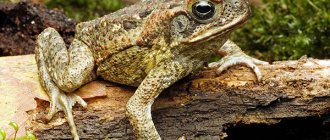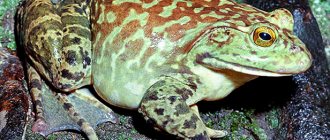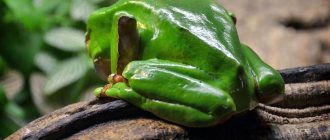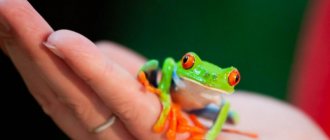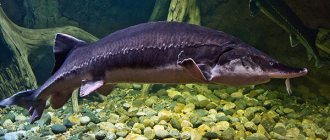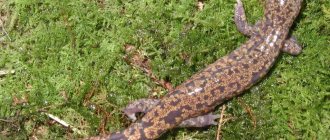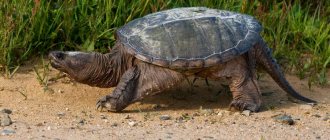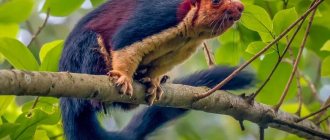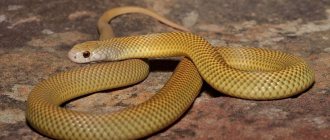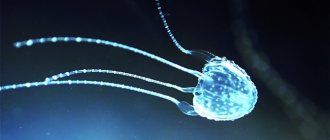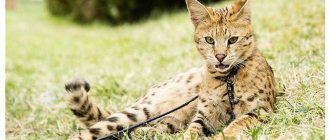City residents most likely do not remember the existence of frogs; they have more important things to do, and children even imagine these amphibians exclusively as heroes of fairy tales.
But lucky people who often travel outside the city probably see frogs often. But only some of them evoke joyful emotions. Many people are disgusted by frogs, and some are even afraid of them. Yes, there are those who still believe that if you touch a toad, warts will appear on your hands.
Our regular "average" frogs look pretty cute. These are miniature creatures and excellent jumpers. Their croaking has a positive effect on the human body. It's even called healing. But there are many species of frogs in the world, and some of them reach gigantic sizes.
If you are interested in this topic or just want to learn something new, read our article. We recommend our list of the 10 largest frogs in the world: a ranking of large and heavy toads that look very scary.
Garlic
Maybe this frog won't make much of an impression on you. The average body length is 8 centimeters and the maximum weight is 20 grams, but compared to other amphibian species it is large in size.
Appearance is insignificant: the body is wide and short, the color is muted, usually gray shades with brown or black spots.
Garlic is a terrestrial species. They are nocturnal and live in floodplains of rivers and lakes. Frogs choose places transformed by humans; they are drawn to loose soil. At night they are completely buried in it.
There is an opinion that people in garlic gardens or vegetable gardens are very lucky. They not only destroy pests, but also loosen the soil. Garlic is absolutely safe for humans.
INTERESTING TOP 10 Best comedies of 2022
Reproduction
In quieter places, with the onset of the dry season, goliath females leave close to 10 thousand eggs. Eggs are laid on aquatic vegetation at the bottom of the reservoir. The process of turning an egg into a tadpole lasts about 70 days. The tadpole is usually born 8 mm long, but after a month and a half it rapidly grows 6 times (4.8 cm).
First, the herbivorous baby goliaths consume aquatic vegetation as food. Over time, they get rid of external gills and tail, grow and gain weight. When healthy, this tailless amphibian grows up to 33 cm in length (sometimes its total length is up to 91 cm) and reaches a weight of three kilograms (maximum 6 kg). Females are slightly larger than males in size. Goliath frogs live about 15 years (maximum age is 21 years).
Purple frog
This frog can only be seen in photographs. It spends most of its life underground, rising to the surface only to reproduce, and this period lasts no more than two weeks a year. It is not surprising that the official discovery of the species occurred in 2003; previously scientists knew nothing about the purple frog.
Habitat: India and Western Ghats. Externally different from other amphibians. It has a massive purple body. At first glance it may seem that they are not that big - only 9 cm in length. But thanks to the rounded body, it seems that the frog is very large.
Curiosity: In 2008, the purple frog was included in the list of the ugliest and strangest animals (according to Scienceray).
Features of behavior
- In Ag, for example, like in green toads, only the father (male toad) is interested in the appearance of offspring and caring for them. To keep the “babies” in proper condition before and after birth, the toad sits in an earthen hole. In the ground at a depth of up to 1 meter, there are just the necessary conditions for the eggs to ripen - dark, damp, warm. The male, having wound ribbons of future tadpoles around his hind legs, awaits hatching.
Toad yeah
- Toads, small and large, will not give a person any diseases if they come into contact with their cover.
- Large toads are helpers in the garden: they quickly exterminate slugs, mosquitoes, small snakes and other annoying pests.
- Toads secrete mucus, which contains analgesic and antiseptic components. If a toad is raised at home, then there is likely to be a strong attachment to the one who raised and fed it. A domestic toad will let a person's relatives and friends know that something is wrong with him, and also gives signs to the owner that he is sick. The toad does this by making sounds, rolling and demonstrating refusal of food.
Rating of giant toads
1. Bufo marinus
According to the BBC, giant toads are found in the genus of toads - Bufo marinus, otherwise cane toads. Location: tropical forests. In the tropics, temperatures reach 40°C during the day and 15-20°C at night. Temperature resonance helps for ideal toad circulatory regulation, heat exchange, life and growth.
The sizes of such toads vary from 15 to 25 cm in length, and toads weigh up to 2 kg, occasionally more.
tropical toad
Among such large toads there was a record holder, who was appropriately nicknamed Prince. As of 2022, the toad is no longer alive, so now the Prince is a museum exhibit that is shown to biologists.
The Prince’s weight reached 3 kg, and his length was 54 cm. What is intriguing is that the “specimen” grew not in natural, but artificially created by man conditions. The Prince belonged to the Swedish botanist Haken Forsberg.
Toad named Prince
Note: toads that do not grow and live in natural conditions reach a size of 4-17 cm in length, while females are 2-7 cm longer than males in length and width. The male Prince became an exception to the rule.
As for physical and external characteristics, toads, unlike others, have long jumping legs and move quickly. And also their color is surprising in that it looks like a turtle - spotted.
Toad Bufo marinus
Aga individuals are dangerous to humans, so it is better to avoid meeting them. The danger is expressed in the fact that during a stressful situation, the toad begins to secrete persistent secretion from the parotid glands. The secretion contains bufotoxin, which negatively affects the functioning of the liver, heart and brain. In case of an “unsuccessful meeting” with a toad, a person will experience convulsions, as well as ischemic attacks. Toads spray toxin within a radius of 20-30 cm. They can use poison in large and moderate quantities, and use it more often for protection than to catch the victim in “their nets.”
Ags live up to 12 years or more. They love darkness, warmth and humidity, and are nocturnal. If it is not so easy to recognize a species by color, then the eyes will serve as an assistant, because the pupils of Ag are elongated, resemble a rectangle and are located horizontally.
2. Blomberg's Toad
If in the first place are toads that reach an average of 20 to 30 cm in length, but among them there are rare winners with large parameters, then Blomberg’s toads almost all have sufficient body volume, mass and length.
Blomberg's toad
Since 2007, this species has been declared endangered, however, earlier in the 18th century, when they were not actively exterminated, Blomberg’s individuals were the largest amphibians. The constant size was 25 cm, sometimes more. The toads were notable not only for their size, but also for their color - red in the dorsal region and green on the abdomen. This type stood out from the rest in that it does not have unevenness or flaking on the skin due to dryness. You can still find the toad to this day in the central states of America.
3. Green and brown toads
In third place are toads from the Green and Brown species. The habitat of such amphibians is limited to the center of Europe and southern Russia. Inhabits reservoirs, swamps, peat deposits and silt streams. The toad reaches no more than 20 cm in length, but 15 cm in width.
green toad
The toad has an amazing color: on the belly and back the color is either grassy with white stripes, or burgundy without inclusions. The skin, like that of other typical toads, is lumpy and dry. The Zelenka specimen is often encountered, since the toad is widespread throughout the globe due to its unpretentiousness and increased vitality. The species is not dangerous, is easily bred at home, feeds on mosquitoes, ant larvae, spiders and spider eggs.
brown toad
It is noteworthy that these toads lay eggs in the fall, and not in the summer, since they hibernate during the hot season. They do not tolerate excessive heat, they like cold and dampness. Not at all dangerous to humans.
grass frog
The most common species in Europe, their range is the territory from the British Isles to Western Siberia. These frogs prefer forests or forest-steppes.
Fat frogs are quite cute, they don't look repulsive. Body length is up to 10 cm, weight up to 23 g, but there are exceptions to the rules - larger specimens.
The color depends on the habitat, usually it is gray, brown, dark green, occasionally red or black individuals are found. By the way, frogs of this species do not croak; they make sounds similar to the purring of a cat.
Habitat
The goliath frog is the largest of all living frog species in the world, living mainly on river banks in the depths of the rainforests of southwestern Cameroon and Equatorial Guinea. Even the photo shows that this is a completely unusual specimen, which is unlikely to be found on the shore of an ordinary body of water. Goliaths prefer to be on the bend of the rocks, where waterfalls of deep tropical rivers form.
Goliaths, unlike other frogs associated with the swamp, on the contrary, prefer perfectly clean water, saturated with oxygen necessary for normal breathing of their skin. The largest frog in the world needs high levels of moisture, so open sunny places are not suitable for it. It also needs a certain temperature: in Cameroon the water always warms up to 22 degrees.
Giant frogs spend time in the water or on their favorite rocks. When a threat approaches, the goliath makes a sharp jump into a body of water, where it hides for 10 to 15 minutes. In a state of safety, amphibians usually settle on gray-brown stones under a waterfall, with which they have similar colors - the skin on the back is greenish-brown, the belly and paws are yellow or white.
Goliaths instantly react to the slightest danger, they are always ready and are able to quickly disappear into the water without a trace. Goliaths are very vigilant, fearful and secretive - they are difficult to approach. These amphibians have very well developed acute hearing and vision, with the help of which they see at a distance of more than 40 meters in order to keep enemies away from them.
Long-legged litoria
Perhaps this beauty can compete even with the frog princess. Unfortunately, it can only be found in New Guinea and Australia. It has quite impressive dimensions - maximum length 14 cm.
Females are often larger than males. They have a bright green color. They live mainly in the forest among trees; it is very difficult to see the long-legged shore in the foliage, even if they sometimes go down to the ground for prey. They are active in the dark.
INTERESTING The largest excavators in the world
lake frog
The largest frog in Russia. Habitat: from central Europe to the east (in Iran). Already from the name it is clear that frogs love water and settle in ponds, rivers, lakes, and reservoirs. They are not afraid of people and also live in big cities, the main thing is that there is water nearby.
Lake frogs reach a length of 17 cm, a maximum weight of 200 g. These are amphibians with a brownish-green oblong body and a pointed snout. There is a yellow-green stripe at the back that helps the frogs remain undetected in the grass. They can be active at any time of the day. Frogs swim and dive a lot and croak very loudly.
Tiger frog
Tiger frogs are distributed from India to Pakistan. They love humidity, their element is ponds and lakes. The length of representatives of this species reaches 17 cm.
The color can be olive, dark green, gray. During the mating season, the appearance of males changes dramatically. They turn bright yellow and the throat sacs change color to bright blue. True beauties, women will not be able to refuse them.
Tiger frogs are nocturnal. They are very greedy, eating insects, snakes and even small rodents and birds. If the prey is too large, the frogs push it into their mouths with their paws.
For reference: these amphibians are very popular in their homeland, they are eaten there. There are even farms for breeding them.
The largest frogs
The size of some of the representatives on this list is amazing. It includes rare, including species of frogs that became extinct at different times, which today can only be seen in the form of museum specimens or in photographs, and modern specimens living in the wild.
Beelzebub frog / Beelzebufo ampinga
The body length of this fossil amphibian, the remains of which were found on the island of Madagascar, was about 41 centimeters. The giant weighed about 4.5 kilograms. Beelzebub is the largest frog that lived during the Late Cretaceous period, 60-70 million years ago.
The appearance of the unusual creature was reconstructed by scientists from fragments of bones and remains. The animal's legs were short, that is, its jumping ability was weak. The wide mouth was lined with numerous sharp teeth, easily able to deal with living prey.
According to scientists, Beelzebub was a predator and spent most of his life in ambush, attacking small animals from there. The diet of the giant frog included lizards, small mammals and even baby dinosaurs. It is believed that from this species comes the subspecies of the slingshot variable, living in South America at the present time.
Goliath frog / Conraua goliath
This exotic “beast” lives in Africa, in Equatorial Guinea and Cameroon. Grows up to 32 centimeters. Weighs about 3 kg 250 g. You can recognize this large frog by its special color: a greenish-brown back and a bright yellow belly.
Goliath
Goliaths live on tropical waterfalls, where they like to sit on rocky ledges, looking out for small crustaceans or spiders and other amphibians that live in the water. Thanks to the exceptional strength of the hind limbs, representatives of this species can jump up to 3 meters in length.
IMPORTANT: Unfortunately, the unique goliath frog is under threat of extinction due to changes in their habitat conditions. In addition, this large amphibian is the subject of hunting by poachers, who destroy them for sale abroad, to countries where frog meat is considered a delicacy and is eaten.
Bullfrog / Lithobates catesbeianus
The favorite habitats of this species are freshwater bodies of North America. The frog got its unusual name because of the mooing sounds heard at a distance of up to two kilometers, made by the male during the mating season.
The body length of the animal reaches from 15 to 25 centimeters. It weighs about 600 grams. If you take such a frog by the hind limbs, then in an extended state it will have a length of up to 50 cm.
The color of the species is olive-brown, with streaks of a dark shade. Bullfrogs or oxfrogs are predators; they hunt any animal they can swallow. These could be small rodents, fish fry, insects, worms, snails or even small reptiles.
Giant bullfrogs are eaten in the southern United States and Canada. Their paws are exported to other countries.
Brazilian Slingshot / Ceratophrys aurita
Named after the region where it lives. Found in the Amazon basin, Brazil. Weighs up to 800 grams.
In addition to its impressive size (adult specimens grow up to 23 cm in length), it surprises with the unusual “dress” located on the head, in the form of horns with a comb-like outgrowth. It is considered a direct descendant of the giant fossil species Beelzebub, albeit in a smaller form. Males of the species are much smaller than females.
The coloring of this amphibian is similar to camouflage in greenish, brown and dark shades in the form of spots with blurred outlines. Slingshot frogs are aggressive and voracious. They eat everything that comes in their way. They even attack animals that are larger than them. Not averse to having a “snack” with their relatives. Because of this, slingshots often die as a result of suffocation due to the inability to push large food down the esophagus.
Tiger frog / Hoplobatrachus tigerinus
This representative of the amphibian order is interesting not only for its large size (with a weight of 450 grams it grows to a length of 15-17 cm), but also for its bright, unusual color.
Under normal conditions, the skin color of this frog is an inconspicuous olive-gray color. During the mating season in males, it changes to colorful lemon-yellow shades, and the throat sacs become deep blue. These amphibians live in southeast Asia, where their meat is used for food. There are even farms being organized to breed them.
Lake frog / Pelophylax ridibundus
The largest frog living in Russia, it is also common in areas of Central Europe up to Iran.
It reaches a length of up to 17 centimeters and weighs about 200 grams. This type of frog lives near water: in ponds, rivers, other bodies of water, and any other reservoirs.
It has an oblong body, colored brownish-green, with a greenish-yellow stripe on the back, which serves for camouflage in the grass. The muzzle is pointed. Representatives of this species are active throughout the day, swimming most of the time and making loud croaking sounds.
Grass frog / Rana temporaria
An indigenous inhabitant of the European continent, living in vast territories from the Urals to Western Siberia and Great Britain.
The size of this variety ranges from 6 to 10 centimeters. Weight – about 50 grams. This is the only species living in the territory of modern Ireland.
The upper part of its body is olive-brownish in color, with dark spots on the sides and back. The color of the abdomen is marbled.
Interesting fact: representatives of this species make special sounds that resemble purring. During the mating season, the male's throat becomes bluish in color. At this time, its color becomes lighter, and in females it becomes more saturated, reddish-brown.
Purple frog / Nasikabatrachus sahyadrensis
Its closest relative is grassy, growing up to 9 centimeters in length. It has an unpleasant, repulsive appearance, making it look like a piece of brown-burgundy mucus.
The impression is further enhanced by the proboscis present on its face. The average weight of this unusual amphibian is about 165 grams. Habitat: mountain ranges of the Hindustan Peninsula.
Common spadefoot spadefoot / Pelobates fuscus
The spadefoot spadefoot lives in Europe, North Africa and Western Asia. This is a very useful animal for the garden.
A characteristic feature of this species is its sharp “garlic aroma”, which it uses to scare away approaching enemies. In adulthood, the body length of this frog reaches 8 centimeters, weight – about 20 grams.
The body is quite wide, powerful, with a movable pectoral girdle. The back is gray, with a pattern of symmetrically located spots or stripes. There may be brownish spots on the sides.
Slingshot changeable
it is also called the Brazilian slingshot. These frogs live exclusively in South America. They reach 20 cm in length, have a rather terrifying appearance, and have horns and a crest on their heads. The color is reminiscent of camouflage: green, brown with dark spots, blurry outlines.
Replacement slings are aggressive in nature. They are known for their excellent appetite. Birds, mice and even.. relatives are used. Frogs are not even bothered by the fact that the prey exceeds their size. Death by suffocation is not uncommon; the sling can neither swallow nor spit out its dinner.
INTERESTING TOP 10 best-selling cars in Russia in 2021
Bullfrog
Bullfrogs live in North America; they choose fresh water. Their sizes are impressive: average length 15 - 25 cm, weight up to 600 g. Color - olive brown with dark veins. You should be wary of such a frog; even small reptiles become its victims.
The bullfrog gets its name from the distinctive fur that males use to call females, as well as its large size. During the breeding season, local residents cannot sleep because of the cries of amphibians. Of course, even giant frogs can't handle humans. In the USA and Canada they are eaten.
Endangered species
Unfortunately, Goliath frogs are an endangered species, their existing numbers are constantly declining due to catching, export, captivity in zoos or private owners, trade, merciless eating and destruction of their safe habitat. Today, in those areas where goliaths lived, active logging has been underway for many years. Poaching fish using chemicals pollutes the water in rivers.
Some tourists, in order to enjoy the meat of this frog, catch it with a spinning rod. In the USA, goliath frogs were even entered into a kind of long jump competition. Goliaths are considered a valuable, healthy delicacy by some local West African wildlife residents.
But the Bayel pygmy tribes and the Fanga tribes living near the Mbia River waterfall do not hunt giant frogs at all, but value and affectionately call them “nia-moa” (“sons”), because the amphibian grows to the size of a baby. In addition, Equatorial Guinea is home to Monte Alen National Park, which is a protected habitat for goliath frogs.
It is obvious that before a person can live in harmony with nature, it is necessary to maintain the safety of its creatures, stop the cruelty to animals and their destruction throughout the world, and then the largest frog will delight our descendants.
Source
Goliath frog
Frogs with a beautiful name can only be found in Equatorial Guinea and southwest Cameroon. Length up to 32 cm, weight up to 3250 g. The back is greenish-brown, the belly is bright yellow.
Goliath frogs are picky and will not live in swamps. Their habitat is waterfalls of tropical rivers. They love to sit on rocky ledges. Despite their impressive size, frogs feed on insects and spiders, worms and other amphibians.
Goliath is facing destruction. Habitat conditions are changing, amphibians are dying out. Not without human participation, people exterminate frogs for further consumption or for export abroad.
What does the largest frog in the world eat?
The food for goliaths is mainly insects (among their favorite foods are locusts, cockroaches, grasshoppers), but they also do not lose sight of rodents, scorpions, spiders, small birds, worms, mollusks, crayfish, crabs, turtles, small frogs and snakes. The amphibian goes in search of prey at night. Thanks to its massive and strong paws, the goliath can make a quick jump up to three meters long, and then press its victim with its body.
Goliaths spend a lot of strength and energy on such an active hunt, get very tired and take a long time to recover. Their most dangerous enemies are humans, large birds, fish, and crocodiles. Goliath frogs do not have vocal cords and do not make any sounds, so they are considered silent animals.
Goliaths stay on wet and slippery rocks using membranes on the toes of their large hind feet. Their powerful paws also help them withstand strong river currents. Therefore, huge frogs settled even on the strong and dangerous waterfall of the Mbiya River.
Beelzebub the Frog
Leader among the great frogs. Length - 40 cm, weight - 4500 g. There is only one caveat: the frog is a fossil. At the moment it can only be seen in museums. The habitat of the Aral Sea is Madagascar; it was in this area that fragments of skeletons were discovered.
Beelzebub frogs are believed to be related to the volatile slingshot. There are some similarities in appearance and behavior. They may have had the same aggressive nature, ambushing their prey. Scientists believe that Beelzebub the frog's diet included newborn dinosaurs.
What are Horned Frogs?
Giant frogs have long been extinct, but they have descendants. The closest relatives of the “devilish” creatures are considered to be horned frogs ( Ceratophrys ). They are not as large as their distant ancestors, but they clearly inherited their large mouths with powerful jaws from them. Horned frogs are distinguished by their aggressive behavior and cunning during hunting. They do not attack their victims directly. As a rule, they attack them from an ambush, and ancient frogs probably behaved in much the same way.
Horned frog
Some scientists believe that, like their descendants, devil frogs had horns on their heads. Most likely, they were also soft and were not used in attacks. According to the researchers, these growths are used by frogs as camouflage and as bait for some species of animals that they feed on. If the ancient creatures actually had them, they most likely used them in the same way.
Horned frogs are excellent at camouflage
Did you know that dinosaur eggs were not covered with shells?
There is no direct evidence of this, but paleontologists are confident that devil frogs could eat dinosaurs. Of course, we are not talking about huge tyrannosaurs and diplodocus - what will they bite their heels? They likely ate baby dinosaurs from time to time. At least the width of their mouth and the power of their jaw could clearly cope with such a task. Assuming this is true, the frogs may have fed on baby dinosaurs that laid eggs only in the semi-dry areas of what is now the island of Madagascar.
Devil frog eats baby dinosaur
